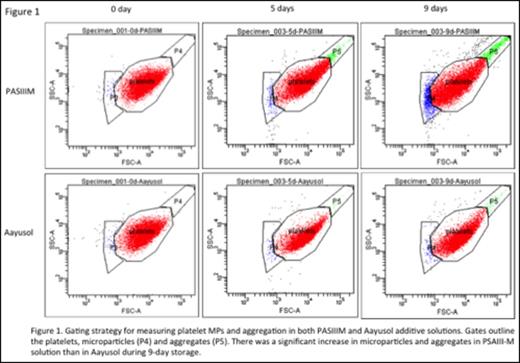Abstract
Introduction: We have recently demonstrated that hearts can be stored in a novel organ preservation solution Somah (Thatte HS et al, Circulation 2009), for an extended 24-hour period at ambient temperature, creating new paradigms in transplant surgery (Lowalekar SK et al, Transplant Proc 2013; Am J Transplant 2014). Somah was significantly modified to address the peculiarities of platelet biochemistry and metabolism, resulting in a novel platelet additive solution, Aayusol, that preserves platelets in a relatively lesion free state compared to PAS-IIIM during 9-day storage at ambient temperature.
Methods: Platelets (20% PRP) were stored in transfer bags containing Aayusol or PAS-IIIM solution (20:80) at ambient temperature with gentle shaking under aseptic conditions. Immuno-Biochemical assays, flow cytometry, and semi-quantitative confocal microscopy were utilized to evaluate platelet viability and function (n=8) during 9-day storage.
Results: The pH levels of both PASIIIM and Aayusol remained stable above 7.1 throughout 9-day storage. Significantly greater amount of platelet microparticles and aggregates were temporally formed, which peaked in PAS-IIIM (>8% & >4%) but not in Aayusol (<3% & <1.3%; *P < 0.05), at day 9 respectively (Figure 1 and Figure 2A and 2B). In contrast to PAS-IIIM platelets, Aayusol platelet morphology was well preserved during storage. Similarly, activation markers- PS exposure and P-selectin expression- (<15%) and (<5%) respectively, were significantly attenuated in Aayusol platelets, but not in PAS-IIIM at 9-day storage (Figure 2C and 2D). Furthermore, GPIba and GPIIb surface receptors, responsible for primary adhesion of circulating platelets to the thrombogenic surface, shed faster and decreased significantly in PAS-IIIM than in Aayusol at 9-day storage (GPIba: 30% vs. 60% and GPIIb: 40% vs. 60%; P < 0.05). Additionally, nitric oxide production was well preserved in Aayusol platelets, with NO fluorescence dye quantum yield of 190 units, which was significantly greater than the comparator, which yielded 105 units, at the end of storage (Figure 2E). As components in Aayusol specifically help modulate aerobic and anaerobic metabolism, lactic acid production was significantly lower in Aayusol (2.8±1.82 mmol/L) than in PAS-IIIM (3.9±0.32 mmol/L; P < 0.05). Correspondingly, high-energy phosphate synthesis (ATP+CP) was greater in Aayusol platelets compared to PAS-IIIM platelets. Temporal agonist (ADP and A23187) challenge resulted in greater activation of Aayusol platelets (over 70% PS and P-selectin expression) than PAS-IIIM (60% PS and 20% P-selectin; P < 0.05) on day 9 storage.
Conclusion: Temporally assessed parameters showed superiority of Aayusol platelets compared to PAS-IIIM platelets. Therefore, based on conservation of structure and function, Aayusol platelet transfusion requirement will potentially be lower than PAS-IIIM platelets, thus increasing the availability of platelets to meet demand, with decreased costs and morbidity in patients. Thus, Aayusol may provide a more viable means of preserving platelets for transfusion.
No relevant conflicts of interest to declare.
Author notes
Asterisk with author names denotes non-ASH members.



This feature is available to Subscribers Only
Sign In or Create an Account Close Modal